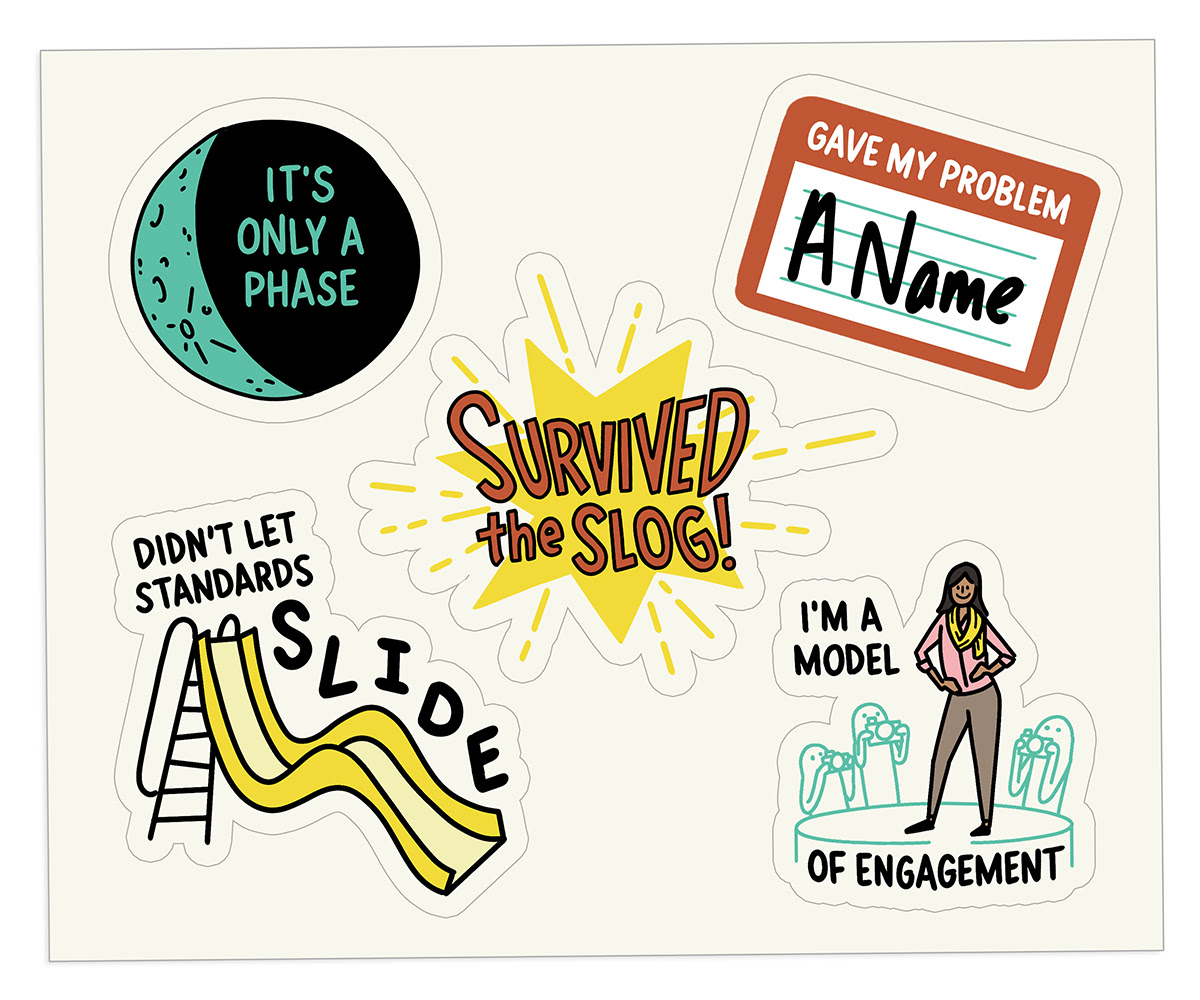Hi Emma and Andy,
I’ve been enjoying your weekly posts and have a topic I deal with often, both as a manager and sometimes personally.
In my line of work, my crew travels the country building specialty construction projects. It’s a ton of work and we like it, but without fail, when we’re about six weeks away from completion, the insatiable itch of “what’s next?” pops up and distracts EVERYONE (including me).
For us, “what’s next” comes with a new city, new climate, and new lifestyle, and it leaves people feeling competitive for the most attractive project — and when those are underwhelming, the most attractive company. Managing expectations when the projects in the pipeline aren’t very sexy is tough. Keeping people engaged through the finale of their current project when the next one is sexy can be even tougher.
Is it just me and this wild world of traveling construction gypsies, or does the grass-is-greener curiosity rear its head in other teams and companies as well?
I feel like some of my younger team members see a photo of a competitor’s shiny new piece of equipment in a better city or state, and suddenly they question their current role. (Not to mention the legions of Talent Acquisition Specialists trolling their LinkedIn profiles convincing them that they’re currently overworked, underpaid, and undervalued).
Do you have any advice on how to know the difference between the grass-is-greener demon and when it really is time to consider other companies? Or, how to manage those who have their noses stuck in the LinkedIn pastures?
Emma: Wow. Yes. You’re facing a few challenges all at once:
- Keeping people invested in a project when it’s winding down
- Managing when the work isn’t fun or glamorous or cutting edge
- Knowing what to say and do when people on your team are exploring different companies
- And also, what do you do when you’re the manager and are in the same boat?
We’re going to tackle half this week and the rest next week.
Andy: To answer your first question: You’re definitely not alone. Lots of businesses in lots of industries have to muddle their teams through acquisitions, IPOs, rapid-growth periods, massive layoffs, changes in leadership, changes in direction, scandals, relocations, competitor poaching — the list goes on.
Emma: I have been through ~six of those and I can attest: They are not easy circumstances to be a boss in. They all indicate some sort of transitional period and, for most people, transitional periods qualify as Big Life Stuff — even when you’re in a job where they’re routine. I’m not entirely sure what a speciality construction project entails, but I assume these “everything feels up in the air” periods happen, what … every 18 months? And I think that’s what makes your situation most unique: how frequently these transitional periods occur. I wouldn’t wish that much transitional time on any team, let alone their manager.
Andy: No way, especially when it’s so easy for the human brain to think that Different = Better.
Emma: On the plus side, you get to get good at this, while the rest of us often just get sandblasted out of nowhere: Surprise! Coach your team through this organizational restructure, okay thanks bye!
Andy: It’s extremely cool that you are going to master this managerial feat. So let’s get down to your first problem: Keeping everyone’s heads in the game when they’re distracted by what’s coming next.
My first recommendation is to not ignore what’s happening. Pretending to go about business as usual when it’s not usual is alienating. Your whole team is sitting there wondering, “Does my boss seriously not get that everyone’s totally distracted?”
Emma: My very close second recommendation is to not force good cheer. It’s incredibly hard to cure ambivalence with a Happy Face, especially for six+ weeks. Instead, call the situation like you see it. Literally name it. You and your team are essentially in a specialty construction version of the Presidential Transition Period — that time between November and January when there’s work to wrap up, but you’re all lame ducks ready for something new. Call it that! Or whatever name resonates for you and your team. Just keep it light.
Andy: It’s refreshing to be direct about this with your team:
I’m as curious as you guys about the new projects, but I am also pumped about finishing this job strong. We’re in the first week of our Presidential Transition Period, and in a few weeks we’ll be on to the next thing. Until then, we’re all-in on this work.
I’ve also found it’s really helpful to diagram these sorts of painful time periods — to draw out the trajectory of the phase. People who are deep in the frontline work aren’t always able to see this high-level view, but as a manager, it’s built into your job. You can create a nice, physical reminder that this is a phase, especially for someone whose only coping skill is just wishing it were over.
Emma: Or daydreaming about a new job with a new company.

How to Draw a Pain Diagram
Draw your own diagram and map where you and your team are at on its trajectory. Then, point to it in 1-on-1s to discuss how it might feel worse before it feels better, what signs indicate this period is coming to an end, when you’ll be in the clear, etc.
Your arc might look like this:

Or it might be another shape:

To figure out what the shape of your experience looks like, answer these questions:
○ What is the rate that things get worse at the beginning?
○ Do they stay that way or do they fluctuate?
○ What is the rate that things get better?
○ Does it happen in stages or all at once?
○ What are the indicators of each phase? What happens when things get harder? What happens that signifies or correlates with them getting easier?

Emma: I think there could be ways to mitigate a distraction problem at a program level — maybe people get rotating Fridays off while the workload is less demanding, or the team gets some sort of “early completion” bonus.
Andy: Even simply shaking up the routine can get everyone looking forward to this time, as opposed to checking out for its duration. It took us a while to identify summer deal slowdowns at Groupon, and then longer to programmatically respond to it. But we eventually put resources into skill-based volunteer projects we couldn’t swing during our super-busy months, got to work on aspirational “someday” projects, and approved way more vacation time.
Emma: Institutional changes are solutions you work up to over time. They take buy-in from the company, coordination across teams, trial and error.
Andy: Totally. A more immediate strategy is to demonstrate the type of behavior you want yourself.
Emma: That, unfortunately, is as hard as it sounds.
Andy: It really is. When I’m as tired of a project as the rest of my team is, I have to reach pretty deep to keep spouting my We’re a team that finishes strong! message. I imagine it’s the same feeling cheerleaders get performing Let’s go, de-fense during the last two minutes of a runaway game: Does this even make a difference?
Emma: Yes! It makes a big difference. I’ve always really admired my bosses who can walk the line of acknowledging the situation around them — Greetings from Slog City! — while also maintaining integrity in their work. I want to hold myself to their standard.
Andy: I recommend when you are around your team to focus on the current work, even if the rest of the time you’re mapping out the next project — or quietly dealing with your own ambivalence. In their presence, continue to remove obstacles. Keep surfacing the work that deserves compliment. Refuse to lower the quality bar.
Emma: You’ll notice if distraction and ambivalence creep into production. And while you can be empathetic — you are in the same slog — there should be consequences.
Andy: It’s the perfect situation to practice one of the not-fun conversations we discussed last week.
Good Boss Achievement Stickers: Those Final 6 Weeks Edition


